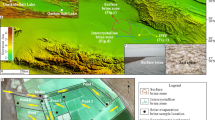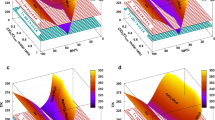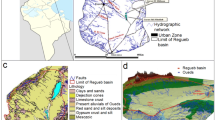Abstract
The evaporation of a range of synthetic pore water solutions representative of the potential high-level-nuclear-waste repository at Yucca Mountain, NV is being investigated. The motivation of this work is to understand and predict the range of brine compositions that may contact the waste containers from evaporation of pore waters, because these brines could form corrosive thin films on the containers and impact their long-term integrity. A relatively complex synthetic Topopah Spring Tuff pore water was progressively concentrated by evaporation in a closed vessel, heated to 95°C in a series of sequential experiments. Periodic samples of the evaporating solution were taken to determine the evolving water chemistry. According to chemical divide theory at 25°C and 95°C our starting solution should evolve towards a high pH carbonate brine. Results at 95°C show that this solution evolves towards a complex brine that contains about 99 mol% Na+ for the cations, and 71 mol% Cl−, 18 mol% ΣCO2(aq), 9 mol% SO42− for the anions. Initial modeling of the evaporating solution indicates precipitation of aragonite, halite, silica, sulfate and fluoride phases. The experiments have been used to benchmark the use of the EQ3/6 geochemical code in predicting the evolution of carbonate-rich brines during evaporation.
Similar content being viewed by others
References
Eugster, H. P. and Hardie, L. A. (1978) In: Lerman A. (Ed.), Lakes: Chemistry, Geology, Physics. Springer-Verlag, New York.
Wolery, T. J. & Jarek, R. L. (2003) EQ3/6, A Software Package for Geochemical Modeling of Aqueous Systems, v8.0
Moller, N. (1988) Geochmicia et Cosmichimica Acta, 52, 821–837.
Rard, J.A. and Wijesinghe, A.M. (2003) Journal of Chemical Thermodynamics, 35, 439–473.
Pitzer, K.S. (1991) Activity Coefficients in Electrolyte Solutions, 2nd edition, Chapter 3, p.75–153, CRC Press, Boca Raton, Florida.
He, S. and Morse, J.W. (1993) Geochimica et Cosmichimica Acta 57, 3533–3554
Acknowledgments
The authors thank Brian Viani and Tom Wolery for their guidance and discussion regarding X-ray diffraction data and thermodynamic modeling, and Kirk Staggs for making these experiments possible. This work was performed under the auspices of the U.S. Department of Energy by the University of California Lawrence Livermore National Laboratory under contract No. W-7405-Eng-48. UCRL-CONF-203520.
Author information
Authors and Affiliations
Rights and permissions
About this article
Cite this article
Sutton, M., Alai, M. & Carroll, S. Evaporative Evolution of Carbonate-Rich Brines from Synthetic Topopah Spring Tuff Pore Water, Yucca Mountain, NV. MRS Online Proceedings Library 824, 481–486 (2004). https://doi.org/10.1557/PROC-824-CC8.49
Published:
Issue Date:
DOI: https://doi.org/10.1557/PROC-824-CC8.49




